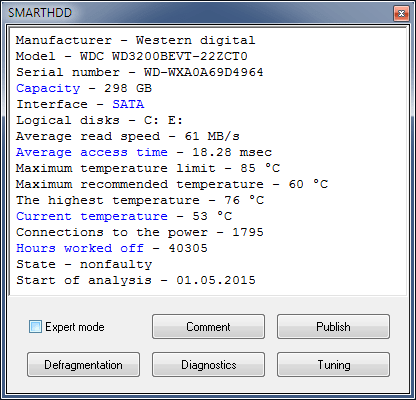Diagnostics and Optimization of Hard (HDD) and Solid-State (SSD) Drives
Every minute SMARTHDD analyzes the condition of every disk in the system and notifies a user as soon as there's information loss risk or anything of the following is detected:
- Pre-failure state of the data storage device
- Data storage degradation
- Non-critical parameters exceeded design limits
- The temperature of a drive is above the recommended value
SMARTHDD evaluates disk performance, defragments file systems and detects fake drives. The unique algorithm of the program detects the manufacturer of an SSD controller even for those SATA solid-state drives that are unknown to the program, which in turn means the program can interpret S.M.A.R.T. attributes correctly in all cases.
SMARTHDD software allows adjusting the characteristics of hard drive and solid-state drives by modifying the positioning speed of magnetic heads (AAM) and fine-tuning power consumption (APM).

Equipped with the S.M.A.R.T. technology, SMARTHDD invokes the built-in self-diagnosis of disk drives. Quick self-diagnosis checks electronic components and the drive head positioning system, this takes about 1-2 minutes. Complete self-diagnosis additionally checks the information storage, this could take up to several hours for high capacity hard drives. The built-in self-diagnosis is performed by the drive itself completely in the background, and, therefore it doesn't affect the performance of the computer. Storage analysis runs at the maximum possible speed of the drive which means the test goes quickly even for those disks that are connected to the appliance via slow interfaces like USB.

SMARTHDD displays drive temperature in the taskbar notification area. To save screen space, the program can be configured to display the temperature of the drive generating the most heat only. If the temperature exceeds the maximum recommended by the manufacturer, the value turns red, otherwise, the program displays it in green. If the program cannot obtain the value of the recommended temperature maximum set by the manufacturer based on drive specifications, it uses the temperature of 55°C (131°F) for HDD and 70°C (158°F) for SSD as the maximum.

SMARTHDD is compatible with Microsoft Windows 7-11 and consumes a minimum amount of RAM and CPU resources, without using third-party libraries other than WinAPI.
 Click the image to view the expert mode.
Click the image to view the expert mode.